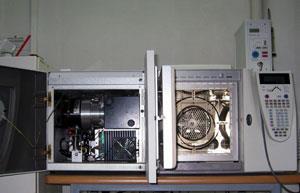With the authorities, medics and analytical chemists struggling to break the flow of new legal highs, the bad guys appear to be getting the upper hand. Sarah Houlton reports
With the authorities, medics and analytical chemists struggling to break the flow of new legal highs, the bad guys appear to be getting the upper hand. Sarah Houlton reports

Humans have always looked for chemical ways of altering their moods and their minds, and recently a new wave of novel psychoactive substances (NPSs) has put the authorities in a bit of a scramble. These ’legal highs’ - perhaps more accurately ’not yet illegal highs’ - pose problems for legislators, police, chemists and clinicians alike. As soon as one is banned, others take its place, leaving everyone playing a game of catch-up.
It’s a growing problem, according to Ana Gallegos, a scientific analyst at EMCDDA, the European Monitoring Centre for Drugs and Drug Addiction in Lisbon, Portugal, which collects and disseminates information on drugs in Europe. ’In 2009, 24 new drugs were identified for the first time,’ she says. ’In 2010, it was 41.’
The number of people using these NPSs is also alarming. A report from the UK’s Advisory Council on Misuse of Drugs, published at the end of October 2011 cites surveys claiming 20 to 40% of young people have tried them. Hospital admissions are rising, and perhaps the most familiar of the NPSs, the now-banned mephedrone, has led to the death of at least 42 people.
’Many [NPSs] are synthetic amphetamine-like psychostimulants, and are likely to share many of the well-documented adverse effects and dependence liability of the amphetamines,’ the report claims. ’The most potent substances are most likely to give rise to a risk of overdose, since the human dose is measured in a few milligrams, an amount equivalent to a grain of sugar.’
A game of catch-up
When a new psychoactive substance is first detected, the data are sent to EMCDDA, which then alerts the authorities in the rest of Europe. ’I receive all the information relating to the substance, its chemical profile, how it has been encountered, when, in what quantities, and if there have been adverse events or deaths,’ Gallegos says. ’The same day, I send an early warning to our network of member states, and designated experts from forensic labs and law enforcement agencies. All the information is stored in a database, and access is restricted to this network.’

It’s difficult to quantify the extent of the NPSs market, as the majority of the trade has been over the internet. EMCDDA monitors the availability of legal highs, both online and in shops. ’We screen the internet to find shops selling legal highs and new drugs,’ Gallegos explains. ’We also buy them from the internet to see which substances they contain, and in what combination. They can say whatever they want on the label, but until someone buys them and analyses their content we have no idea what they are.’
The authorities face a real problem keeping up. It can take 12 months or more for a new drug to be banned - plenty of time for dealers to move on to another. This has been partially overcome in the UK by the use of import bans, which can be implemented very quickly, allowing border control authorities to intercept and seize shipments. At the beginning of November 2011, the ’temporary class drug’ was created. Essentially, it allows a material that has not been through the normal checks and balances to be given an instant 12?month ban, giving time to assess it properly and decide whether it needs to be controlled. This can be done in a matter of days.
Challenging the medics
While usage remains relatively small compared to more traditional drugs of abuse - such as cocaine, cannabis and ecstasy - the unknown nature of NPSs when they appear poses problems for medics. Even if the patient can report accurately what they have taken, doctors remain in the dark about what the treatment should be.
Consultant clinical toxicologist David Wood of Guy’s and St Thomas’ hospital in London, UK, says patients tend to be treated according to symptoms rather than toxicological screening results, as these are rarely available in time to alter an individual’s care. ’Symptoms with NPSs are very similar to other classical recreational drugs,’ he says.
’The patient may not be aware they have taken a novel substance. Cathinones such as mephedrone, and various other classes including piperidines and BZPs [benzylpiperazines], all have very similar patterns of acute toxicity to amphetamines and cocaine, and new hallucinogenic drugs like the tryptamines look very much like ketamine and LSD.’
While Wood and his colleagues have published a number of examples where they have identified the drug a patient has taken, this is not routine. ’It’s useful for research and from a legislative point of view to know what people are taking, but for an individual patient it will rarely alter the way they are treated, so consent is needed for screening,’ he says. Only low double figures of patients are screened per year - when they have admitted to taking something new, or when the clinical features are not consistent with what they claim to have taken.
Tracing the source
A method that might be used to trace the source of NPSs is being developed by Oliver Sutcliffe and colleagues at the University of Strathclyde, UK. ’We started making reference substances a couple of years ago, notably mephedrone,’ he says. ’However, analysing an illicit substance using GC [gas chromatography] or LC-MS [liquid chromatography-mass spectrometry] may tell you the components that are present in the sample, but it doesn’t give you any information about where it might have come from. We’re using isotopic ratio mass spectrometry to try to get this.’
The technique measures the ratio of C-13 to C-12 atoms in a molecule, which is specific for that compound and depends on the starting materials used. ’Theoretically, this should be consistent throughout the synthesis as a potential fingerprint,’ he says.
’We bought two samples of the mephedrone starting material from different suppliers, and we could discriminate between them using the isotopic ratio.’ When they used it to make mephedrone, it also tracked back through the synthesis. ’It’s not an absolute method, as isotopic ratios can vary dependent on the synthetic scheme. But as a proof of principle, it does look like we could use this to track the drug back to its original source.’
Masking the truth
A patient may think they know what they have taken, but there’s no guarantee that’s what it actually contained. Even named chemicals are often not what they claim to be. It’s even less clear what products sold under non-chemical names will consist of, and the same product may change over time, perhaps because the original has become controlled, or because they can’t get hold of it any more. Whatever the active substance, the products will likely be labelled ’not for human consumption’ and be masquerading as something else - such as plant food, bath salts or window cleaner.

Ric Treble, scientific adviser at LGC in Teddington, UK (a company that produces reference standards to assist in the identification of legal highs), cites the product Ivory Wave as an example. The Ivory Wave packaging suggested it was soothing bath salts, but it was actually a potent stimulant. ’As various chemicals became controlled, there were different iterations of the product with a new chemical in it,’ he says. ’At first, it was the cathinone methylenedioxypyrovalerone. The UK banned this, and it reappeared with naphthylpyrovalerone. When this too became controlled, it reappeared again with desoxypipradrol, a particularly potent stimulant, which is metabolised very slowly in the body. This led to numerous overdoses.’
Even less is known about long term effects, as these take time to appear. Take the licensed anaesthetic ketamine. It is now a controlled substance in the UK after it started to be used as a hallucinogenic, and in the past few years it
has become clear that persistent use severely damages the bladder - something that does not occur with short term use. ’We don’t yet know how dangerous [the] new substances are as there is so little information available,’ Treble says. ’But they are being used by young people in relatively large quantities, we think, so the risk is clearly there.’
Misappropriated research
he scientific literature provides a rich source of ideas for those looking to produce the next legal high. Should legitimate science still be published, even if it is playing into the hands of those who are up to no good? David Nichols at Purdue University in the US, who has been affected because of his work on neurotransmitters, firmly believes it should.
A number of NPSs originated from his lab in this way, he says. ’It seems to be happening more often, with rapid access to information on the internet. When I talked about the problem in print last year, I got a huge number of responses, mostly saying you can’t control what people do and the risks they take. People have to be personally responsible for what they do.
’The paradigm for basic scientific research is that you publish everything, unless it is a national security issue. But for something like this, there is no precedent to keep you from publishing. If you are trying to understand how a particular class of drugs interacts with the body and biological targets, you want to publish that information for the benefit of other scientists working in the area.’
Challenging the chemists
Identifying the structure of new psychoactive substances when they first appear is a real problem for analytical chemists. Take the smoking mixture, Spice. It was marketed as a legal herbal material and sold openly for some years before it became clear it contained synthetic cannabinoids. ’There are hundreds of potential synthetic cannabinoids that might have been in it,’ Treble says. ’While the analytical data might indicate you’ve probably got a new synthetic cannabinoid, it’s difficult to nail down exactly which one.’
Gallegos agrees that identification is a real problem. ’These drugs are sophisticated in terms of chemical makeup, and often mixed with other drugs, which makes it difficult for mass spec labs to identify them,’ she says. ’If police seize a sample of powder at an airport, for example, it’s not that expensive to check whether it is one of the four or five most common drugs. To take this sample and screen against a huge library of compounds is expensive and time consuming, and requires expertise.’
Advanced analytical techniques are essential for real unknowns, Treble says, yet these are unlikely to be available to the routine drug testing lab. ’If you have a reference standard, it’s easy - simply run the unknown through the GC-MS [gas chromatography-mass spectrometer], look at the retention time and the mass spectral pattern, and if it matches the reference standard, that’s what it is,’ he says. ’But for something that’s not been seen before, it requires NMR or high-resolution mass spec analysis. While these might be routine in university chemistry departments, few run-of-the-mill local drug testing labs have those facilities or skills.’
This absence of reference standards will be difficult to solve. ’At LGC we produce them as quickly as we can, but it takes time,’ he says. ’Normally, you can assess what is heading to the market in coming months, and have a reference standard for a new pharmaceutical or a pesticide ahead of its launch,’ he says. ’But for a legal high, analytical chemists want the reference standard today - in six months’ time it might have disappeared from the market.’
Without reference standards, the structures have to be worked out from first principles, and as many are closely related homologues, analogues and structural isomers, it’s a real challenge to work out precisely what it is. It may be obvious it’s a cannabinoid derivative or an amphetamine-type compound, but which one is another matter entirely and poses a real analytical challenge.
An additional layer of difficulty comes when the sample isn’t a nice, neat white powder, but a biological sample. ’If a lab is looking at urine or blood samples of a person who’s suspected of driving under the influence, for example, they also need to look for metabolites,’ Treble says. Metabolites are the chemicals formed as the body breaks the drug down, and will be present in the sample if a person has taken the drug.
It can be a couple of months before a NPS advertised on the internet attracts the authorities’ attention, and several more months are taken up getting samples and identifying them. ’The toxicologists then get to work and start feeding it to rodents to try to work out what the metabolites are,’ he says. ’Suppliers have a free run for months, if not years, before the analytical results are available. Police and legislators are running along behind the suppliers, who are always coming up with something new. Unless you’re careful, you will always be controlling new materials and simply encouraging the production of more designer drugs to evade the controls.’






No comments yet